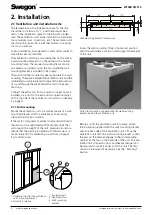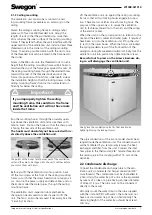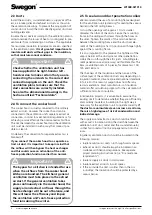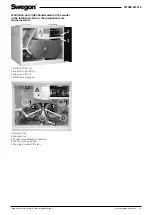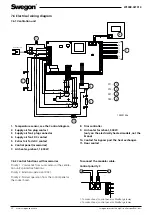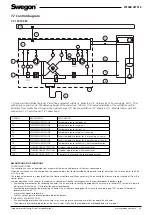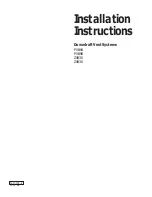
8
W100B.021014
Swegon reserves the right to alter specifications.
www.swegon.com/casa
2.3 Ducts
Install the air ducts, sound attenuators, supply air diffus-
ers, air intake grilles and exhaust air ducts as shown in
the ventilation drawings. To prevent the propagation of
sound, do not install the ducts directly against structural
building elements.
Insulate the air ducts according to the ventilation plan in
order to reduce the losses of heat or cooling and to pre-
vent water from condensing on surfaces. The applicable
fire resistance insulation requirements are also specified
in the ventilation plan.
It is of greatest importance to
insulate cold ducts without gaps in the insulation,
so that moisture cannot condense.
2.4 To connect the cooker hood
The cooker hood is usually connected to the ordinary
extract air duct. However the cooker hood can be
connected to the ventilation unit’s separate extract air
connection, in order to meet national regulations or for
achieving a more effective than normal extract airflow.
The duct between the cooker hood and the ventilation
unit must be installed in such a way that makes it pos-
sible to clean it.
On delivery, the connection for separate extract air is
blanked off.
If you connect the cooker hood to a separate ex-
tract air duct it is important to keep in mind that
the airflow will then bypass the heat exchanger
and this could cause an activation of the anti-
freeze protection function earlier than normal.
Important
The bypass for a kitchen is intended for use
when the airflows from the cooker hood/
kitchen are boosted. The kitchen’s general
ventilation must take place via the extract
air duct. If the general ventilation takes
place continuously via the cooker hood, the
supply air and extract air flows through the
heat exchanger will be out of balance, and
this will lower the efficiency and impair
the ventilation unit’s anti-freeze protection
functions during the winter.
2.5 To seal around duct penetration collars
We recommend the use of a mounting frame designed
for the ventilation unit (accessory) for sealing the vapour
barrier in the loft ceiling beams.
Cut up the openings with approx. 10 mm smaller
diameter than that of the ducts. Secure the mounting
frame in the ceiling with screws through the holes on
the sides. Tighten the plastic of the moisture barrier
between the mounting frame and the structural ele-
ment of the building or fix it in position with tape tightly
against the mounting frame.
It is also important to the preserve the tightness of the
vapour barrier at the duct system’s other penetration
collars that run through the attic joists. A building ele-
ment penetration seal (accessory) will facilitate this. This
item is available in sets of 5 pieces, for diameters: 100,
125 and 160 mm.
The thickness of the insulation and the nature of the
surface layer of the ventilation ducts vary depending on
insulation material, climate zone and national standards
in force. For this reason, Swegon does not offer any
recommendations. Most manufacturers of insulation
material offer calculation programs for the calculation of
sufficient and correct insulation.
In renovation projects, it is advisable to examine the
existing ducts to determine whether they are sufficiently
and correctly insulated. Insulating in the right way is
necessary for the ventilation unit to operate correctly..
If
the ducts are uninsulated, even across a small area,
there is a high degree of risk of condensation and
indirect damage.
The supply air and extract air ducts should be fitted
with acoustic insulation along the stretch between the
ventilation unit’s duct outlet and the sound attenuator,
so that fan sound will not be propagated out into the
room.
In general, ventilation ducts should be insulated in the
following manner:
• Insulate outdoor air ducts run through warm spaces.
• Exhaust air ducts should always be insulated in ac-
cordance with national regulations. See separate
project planning instructions (e.g.e ”Fire resistance
requirements”).
• Insulate supply air ducts in cold spaces.
• Insulate extract air ducts in cold spaces.
• If the air inside the duct is colder than in the sur-
roundings; the insulation should be protected by a
vapour barrier.
Important
Check whether the ventilation unit has
been supplied in the right-hand or left-
hand version to make certain that you are
connecting the air ducts to the correct duct
connection spigots on the unit. Check the
ventilation plans to make sure that the
duct connections are correctly installed.
See also the dimensional drawings in the
Section entitled: “Technical data”.
!
!
!
!






